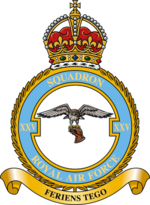Our website is made possible by displaying online advertisements to our visitors.
Please consider supporting us by disabling your ad blocker.
No. 25 Squadron RAF
| No. XXV (F) Squadron RAF | |
|---|---|
 | |
| Active | 25 September 1915 – 31 January 1920 1 February 1920 – 23 June 1958 1 July 1958 – 30 November 1962 1 October 1963 – July 1989 July 1989 – 4 April 2008 8 September 2018 – present |
| Country | |
| Branch | |
| Part of | No. 4 Flying Training School RAF |
| Motto(s) | (Latin): Feriens tego ("Striking I defend")[1] |
| Equipment | BAE Systems Hawk T.2 |
| Battle honours |
|
| Insignia | |
| Squadron Badge heraldry | On a gauntlet a hawk rising affrontée[2] (The badge incorporates a previous badge used unofficially by the Squadron, the hawk being associated with the Squadron's period at RAF Hawkinge.)[3] |
| Post 1950 squadron roundel |  |
| Squadron Codes | RX (Dec 1938 – Sep 1939) ZK (Sep 1939 – Apr 1951) FA–FZ (July 1989–Apr 2008) FA–FM (Sep 2018–present) |
Number 25 (Fighter) Squadron (alternatively Number XXV (F) Squadron) is a squadron of the Royal Air Force having reformed on 8 September 2018.[4]
During the First World War, No. 25 Squadron operated as a fighter-reconnaissance unit and later as a bomber squadron. Pilots from the Squadron, Cpl. James Henry Waller and 2nd Lt. George Reynolds McCubbin, shot down the famous German fighter ace Max Immelmann in June 1916. In the inter-war years, the Squadron was based at RAF Hawkinge, from where No. 25 Squadron's badge originated. Throughout the Second World War, the unit flew both bombers and escorted bombers. In the 1950s, it became a night-fighter squadron. Between 1963 and 1989, No. 25 Squadron operated the Bristol Bloodhound Surface-to-Air Missile from RAF Brüggen, West Germany and later RAF Wyton, Cambridgeshire. The Squadron regained its wings in July 1989, operating the Panavia Tornado F.3 interceptor, these were flown until April 2008 when the Squadron disbanded.
Since reforming in 2018, No. 25 Squadron operates the BAE Systems Hawk T.2. It provides Advanced Fast Jet Training (AFJT) for pilots of the RAF and Royal Navy, as part of No. 4 Flying Training School at RAF Valley.
- ^ Pine, L.G. (1983). A dictionary of mottoes (1 ed.). London: Routledge & Kegan Paul. p. 74. ISBN 0-7100-9339-X.
- ^ Rawlings 1978, p. 66.
- ^ "Squadrons of the Battle of Britain. Aircraft, badges and history - 1 to 25 Squadrons (Archived)". raf.mod.uk. Archived from the original on 8 December 2011. Retrieved 11 December 2018.
- ^ "XXV (F) SQUADRON". Royal Air Force. Retrieved 15 February 2019.
Previous Page Next Page


